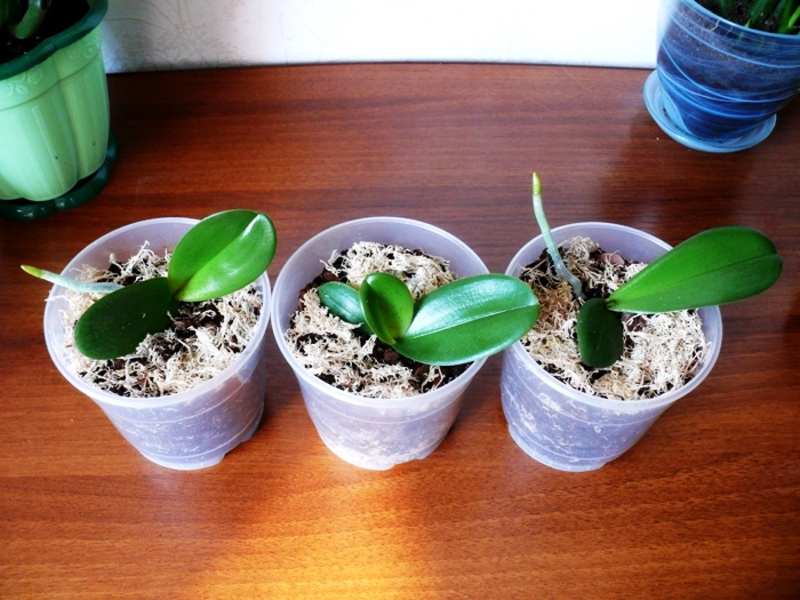Many lovers of growing beautiful flowers at home, having brought home an orchid, wonder how to properly care for it? What is required for this?
First of all, you need to arrange a kind of quarantine for the plant. It needs to be put in a secluded place for two weeks, away from other home flowers. Moreover, the sun's rays should not fall on the plant, it should be in complete rest. At this time, the plant does not require additional fertilization.
Content
How an orchid transplant is done at home
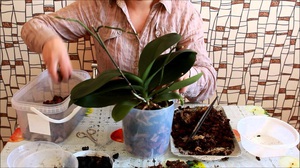 If you have just brought an indoor flower home, then you do not need to transplant it. The plant will feel great in its own substrate for a couple of years. It is necessary to transplant the plant only if it is in sphagnum moss.
If you have just brought an indoor flower home, then you do not need to transplant it. The plant will feel great in its own substrate for a couple of years. It is necessary to transplant the plant only if it is in sphagnum moss.
Flower need gently remove from the pot... During this operation, you should try not to damage the root system. Sometimes you even have to cut the pot.
The roots are freed from the substrate, dried and rotten ones are removed. Then everything is washed with clean running water. Orchid placed in a new pot with a substrate, add soil, until the empty cavities between the roots are filled.
It is forbidden to cover the top of the flower, it should always be on the surface. The soil is moistened, the pot with the orchid is placed in a dark place and kept for several days.
Gardeners believe that the plant is under stress after transplanting, so it needs to be treated with special flower anti-stress»... Orchids do not need this, she herself is successful copes with stress and easily adapts to new conditions, which is clearly seen in the photo.
It is not required to treat the orchid leaf with insect-killing drugs. Do not poison a plant that has just undergone a move.
What kind of lighting is required for an orchid
 Looking at a photo of a colorful orchid, you always wonder how to create the right lighting for this plant at home. Indeed, its future flowering and growth largely depends on this.
Looking at a photo of a colorful orchid, you always wonder how to create the right lighting for this plant at home. Indeed, its future flowering and growth largely depends on this.
Under normal lighting, the flower will delight the eye with beautiful flowers, and if there is not enough of it, the leaves will begin to acquire a light green color, begin to stretch, and begin to turn yellow.
To make the flower look like in the photo, need to create lighting, according to certain rules:
- Indoor orchid grows well in diffused light. Direct sunlight has a negative effect on the orchid. This nuance must be taken into account when caring for an orchid at home.
- In the summer, it is advisable to put the plant in a darker place. This is especially true for a location where the hot rays of the sun hit the leaves.
- In the autumn, the indoor orchid does not require darkening. The amount of sunlight decreases, the shoots of the orchid begin to ripen. She begins laying new flower shoots.
- For this plant, the duration of daylight hours is of great importance.It should last at least 12 hours. With a decrease in daylight hours to 10 hours, artificial lighting is required. For this purpose, you can use the fluorescent bulbs shown in the photo.
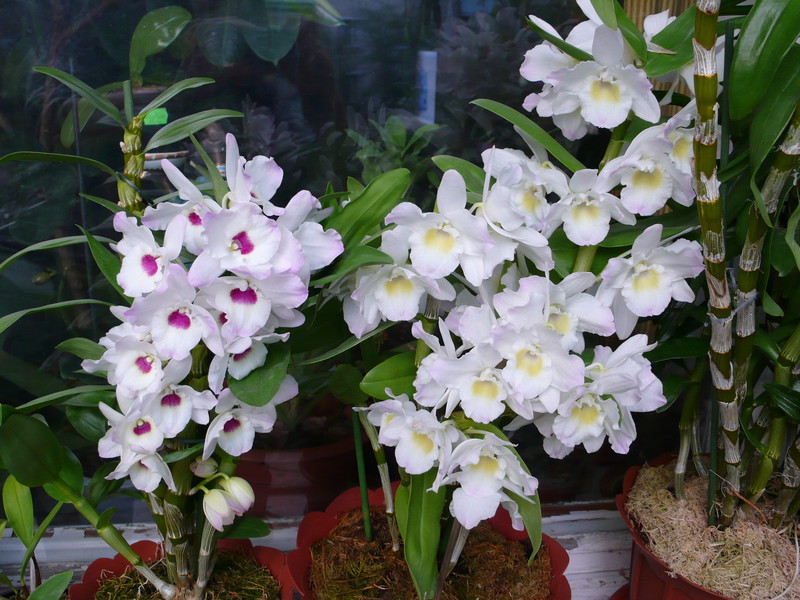


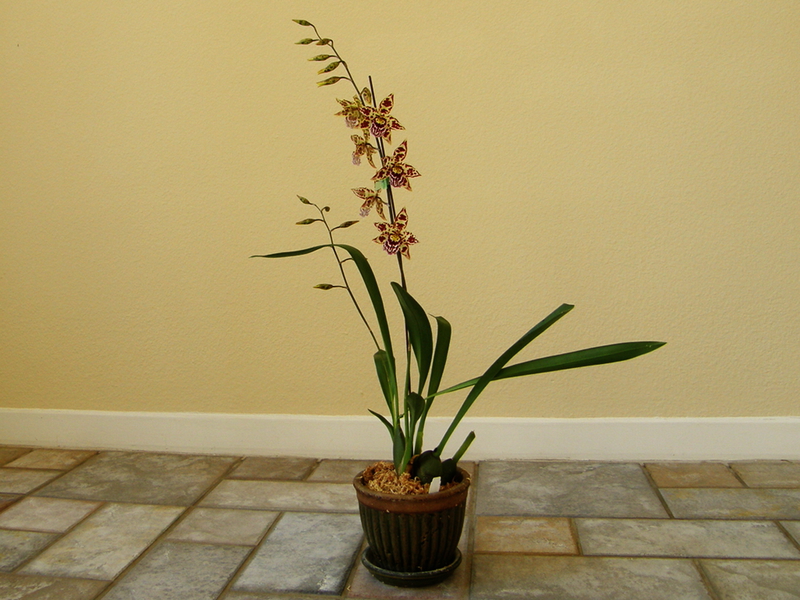
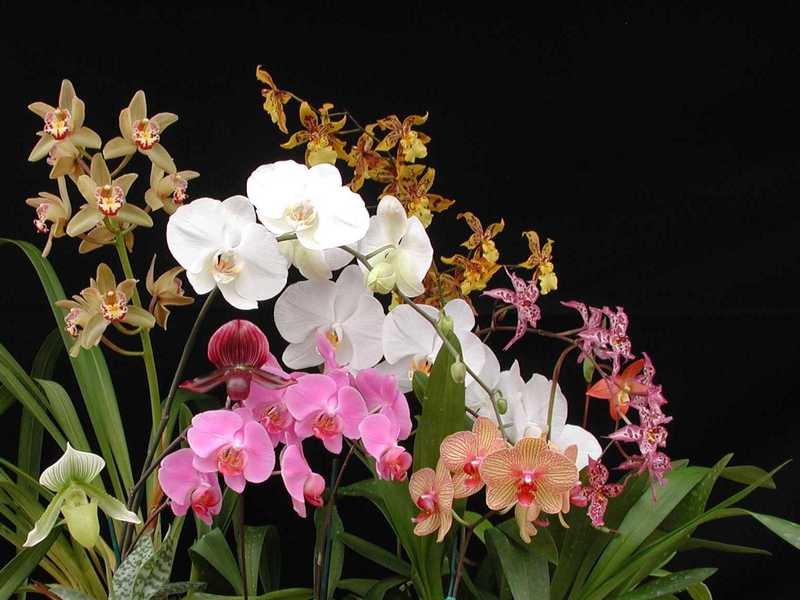
Known three kinds heat-loving orchids, which require a certain temperature regime. These include the following names:
- Dendrobiums.
- Phalaenopsis.
- Cutley.
Since these plants are native to tropical forests, they must be kept at a temperature of no more than 32 degrees. At night, the temperature should not drop below 18 degrees. The temperature drop per day should not exceed five degrees.
Medium temperature orchids
The plant is divided into several types, the name of which is:
- Miltonia.
- Odontoglossums.
Houses must be created for such an orchid cooler mode... In summer, the daytime temperature should not exceed 22 degrees, on winter nights the temperature can fluctuate in the range of 12-15 degrees.
Cold-loving species
Such orchids are found in subtropical climates, grow in the highlands and have the following names:
- Dendrobiums.
- Lelia.
- Paphiopedilums.
The plant grows well in summer at a temperature of 22 degrees, and in winter no more than 15 degrees. Almost any kind of orchid grows well at homewhen the daytime temperature does not exceed 27 degrees, and the nighttime temperature does not exceed 24 degrees.
How to water orchids at home
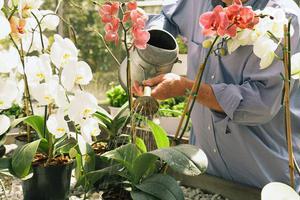 In order for the plant to develop well and delight the eye with beautiful flowers, as in the photo, it is very important to water it correctly. In natural conditions, orchids do not grow in water, they cannot tolerate stagnant moisture for a long time.
In order for the plant to develop well and delight the eye with beautiful flowers, as in the photo, it is very important to water it correctly. In natural conditions, orchids do not grow in water, they cannot tolerate stagnant moisture for a long time.
Therefore, it is necessary to water the orchid at home in the same way as in the real conditions of its residence. For example, the Phalaenopsis flower loves a slightly moist substrate, but for Oncidium it must be completely dry. In other words, for each type of orchid certain watering is required.
In addition, the intensity of watering depends on other factors:
- temperature;
- humidity;
- lighting;
- dimensions of the pot;
- the composition of the substrate;
- seasonal vegetation.
Since orchids are epiphytic plants, they are able to withstand a little dry soil.
However, if the orchids stop watering, they start to fade quickly, the leaves become wrinkled and unsightly. If there is an excess of moisture, the roots will begin to rot, and the perimeter of the leaf will turn yellow. This is very clearly seen in the presented photo.
Orchid needs pour soft water... The most suitable is considered to be well-settled in the summer, rainwater. In winter, you can organize watering with melt water.
If you water a flower with tap water, then it is necessary pre-boil... The water temperature should be three degrees higher than room temperature.
In the summer, watering is carried out several times a week, but no more than three. And only when the top layer of the substrate begins to dry out.
In winter, it is enough to water the plant a couple of times a week, when the pseudobulb begins to wrinkle.
If a flower grows in a pot, it is watered from above; if in baskets, then they are simply dipped in water for five minutes. Excess water must drain completely, it must not stagnate.
Required fertilizers
You need to feed the plant only when it grows. Fertilizer should be applied once a month. The most suitable are:
- Greenworld.
- Pocon.
- Bona Forte.
It is very important to add fertilizer according to the proportions indicated on the package. The plant does not tolerate large accumulations of mineral salts in the soil. The orchid may just wither.
That is why the substrate, before adding fertilizer, needs rinse with clean water... Flushing and feeding should be alternated every week.
Fertilizers intended for other types of flowers are not suitable for an orchid. You do not need to feed the plant in winter and when it is dormant.
How does orchid propagation
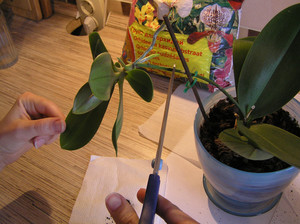 Reproduction by "Children"... By “babies” we mean small new plants from which new orchid species can emerge. These lateral shoots most often appear in plants with a high nitrogen concentration.
Reproduction by "Children"... By “babies” we mean small new plants from which new orchid species can emerge. These lateral shoots most often appear in plants with a high nitrogen concentration.
When "children" appear, it is advisable to spray the orchid more often. After the “kids” have grown up and given roots, they can be separated, treated with charcoal and planted in a separate pot.
Type of reproduction by layering... For reproduction, layers are used, which are found only in sympodial flowers. To work, you will need to create a small greenhouse located directly above the bent part of the stem. Then you need to moisten the moss and wait until the sleeping bud begins to awaken.
If the shoot does not have foliage, it is located horizontally in the greenhouse, it must be constantly heated, and regularly moistened. After about 30 days, the dormant kidneys will wake up. Young plants, green leaves and roots will appear.
When small plants are well established, they are carefully separated from the main shoot, processed and planted in a small pot. It is not necessary to remove the plant from the greenhouse immediately. Let it stand there for a few days.
Vegetative breeding method
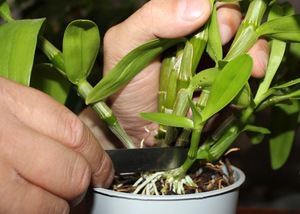 It is suitable for any kind of orchid. The roots of the flower are simply divided into several parts, each of which has two pseudobulbs. Only large orchids can be propagated this way.
It is suitable for any kind of orchid. The roots of the flower are simply divided into several parts, each of which has two pseudobulbs. Only large orchids can be propagated this way.
The flower is removed from the pot. The roots are carefully separated from the soil. Rhizome cut into several pieces, on which a few bulbens remain.
The cut is sprinkled with charcoal. The planting of each fragment is done separately. New flowers should be lightly watered and sprayed daily until the plant sprouts and leaves appear. This will be further proof that the orchid has begun to grow.
Caring for an orchid at home after flowering
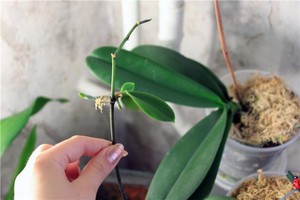 When the indoor flower is at rest, you do not need to water it. It is enough to monitor its condition, the color of the leaves and other parts. It will be nice to take a photo of the flower at this time, so that later you can compare its new state with the old one.
When the indoor flower is at rest, you do not need to water it. It is enough to monitor its condition, the color of the leaves and other parts. It will be nice to take a photo of the flower at this time, so that later you can compare its new state with the old one.
Such a kind of quarantine is necessary for the detection of flower pests, and further control of them. Two weeks will pass and the orchid can be put on the window, it should get used to the sun. You can start to lightly water the plant.
The field of the end of flowering, when the peduncle has completely dried and become black, its cut under the base and removed. When flowering is complete, much less feeding is done. In winter, orchids are watered once every 30 days, the plant is sprayed several times a month.
I must say that if you need to transplant a flower, then in order for it to bloom in the future and its leaves turn green, you need to put the pot in another place.
In the case when, after flowering, the orchid began to wrinkle and turn yellow leaves, the peduncle completely stopped, the pot also need to rearrange... It will begin to bloom again.
Let's summarize all of the above. If you take proper care of orchids at home, you can always enjoy the sight of these beautiful flowers at home.

